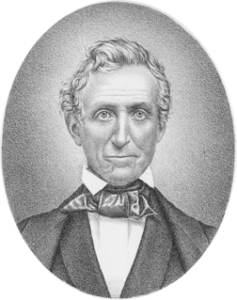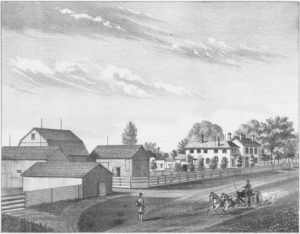Abner B. Buckland was born in Burlington, Vermont on October 19, 1797. When he was 3 years old his father, Captain Buckland, moved the family to a 50-acre farm he purchased in Phelps, New York. In 1815, his father sold that farm and came to Brighton bringing Abner, his eldest son. The Captain bought an area of dense forest, cleared an acre and built a log house. Unfortunately, he became ill and died soon afterward. According to the book entitled History of Monroe County, Abner’s father “was unsuccessful in business and, not being able to make his payments, lost all his property.” Abner was 18 years old when he was left responsible for his widowed mother and six siblings without money or a place to live.
With hard work and boundless energy, Abner was able to support his family and within six years had also saved a hundred and fifty dollars. In 1827, after careful consideration of the area, he bought land previously owned by Nathaniel Gorham. Since Gorham was deceased, the land was purchased from his son, also named Nathaniel and his widow Ruthy Gorham.
In the 1820’s, the area near the corner of East Avenue and Winton Road was known as Brighton Village. It was the town’s social and economic center of activity. This was in part because the Erie Canal went right through the intersection, making Brighton a very lively canal town. There were taverns on three of the four corners, a hotel and about 30 houses. A brick church stood on a hill overlooking the canal at its bend. (This is now the expressway intersection of Routes 490 and 590.) The church is long gone but the nearby cemetery is still there, located at the end Hoyt Place off Winton Road. Brighton Cemetery, established in 1821, was part of Brighton Village until this area was annexed in 1905 by the City of Rochester.
Aside from this busy village, the rest of Brighton was mostly rural at this time. Plots of land were sold and farms, nurseries, saw mills, and brick factories were developed along Monroe Avenue and southward to 12 Corners. Abner’s new homestead was here, on Winton Road, then called South Avenue, about a mile from Brighton Village.
Abner Buckland built a log house on his new land, cleared the area and established the Buckland Farm. At the same time he began the manufacture of clay bricks at a location just south of his farm on Winton, near Westfall Road. Around 1820 a huge clay deposit left by glaciers was discovered running through the center of town. Abner was one of the first brick makers in this area. He farmed and ran his brick company for the next thirty years.
Abner married his wife Fanny in February of 1824. Together they had eight children. In 1830, Abner built a brick house, with his own bricks, at 1037 Winton Road South. This house remained in the Buckland family for 109 years. It is still fully intact and hints of its former stateliness. In 1997, the house was sold to the Chabad Lubavitch of Rochester, a Jewish Enrichment Center. There is a photograph of the house, probably as it was a hundred years ago, on the staircase wall just inside the entrance of the Center. It shows one young man in a horse and buggy near the left side of the house and two young women standing together on the front porch.
Abner B. Buckland died in 1865 at the age of 68. Many of Rochester’s finest structures were built of bricks from his factories. Abner and 30 of his family members are buried in the Brighton Cemetery.
David Buckland was the eldest son of Abner and Fanny. He and his first wife Jannett had four children before he died at the age of 37. Their eldest son, Abner M. Buckland, was only 8 years old at the time. Since Jannett had also died, Abner M. and his siblings lived with their Aunt Martha Buckland and remained at the Buckland house.
Through the years the Buckland Farm, comprising 98 acres of land that is now Meadowbrook, became the property of Abner M. Buckland and his wife and children. In 1926 Abner, then being upwards of 70 years old, sold the Buckland Farm to the Kodak Employees Realty Corporation. He reserved for himself and his family the land around his house measuring only 250 by 193 feet, which remained in the family until 1939. Abner M. Buckland died in 1935. His death was mentioned in the June 1935 issue of our neighborhood newsletter, The Meadowbrook Dandelion. It read, “The recent death of Abner M. Buckland marks the passing of the late owner of the land on which Meadowbrook is built. Buckland Avenue was named in his honor.”


